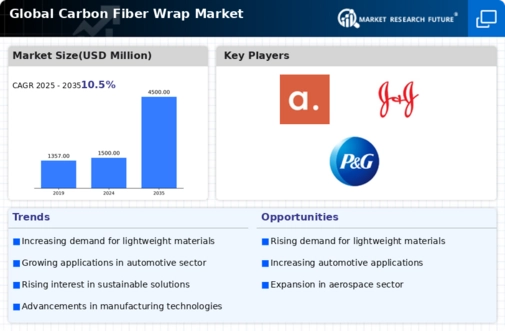Market Trends
Key Emerging Trends in the Carbon Fiber Wrap Market
The market for carbon fiber wrap is facing certain trends that deal with the surge in the use of lightweight and high-strength types of materials which are found in various industries like automotive, aerospace and construction. Carbon fiber wraps, abbreviated as CF conducting polymers (CFRP), have desirable strength-to-weight ratio, corrosion protection and versatility in design. And if these features were coupled with their preference for structural reinforcement and cosmetic improvement, one can easily say CFRP is the best choice.
The carbon fiber wraps demand in aerospace sector is activated by the need for lightweight structures that are meant to increase the fuel efficiency as well as capacity of aircrafts. Composite materials containing carbon fiber are employed in manufacturing of aeroplan details, such as wings and fuselage sections, and thus are one of the tools that aviation industry uses to save fuel and thereby be more environmentally friendly.
As a result of the building sector, the Carbon Fiber Wrap Market constitutes one of the core forces of trends. These are carbon fiber wraps highly used for bridges and buildings refurbishment to make them more durable through strengthening. In comparison with the traditional repair method, a carbon fiber wrap advanced a great deal in strength, as well as the durability, which makes them suitable for the endurance of aging infrastructure. When infrastructure projects aim at refurbishing and maintaining the structural integrity of existing assets the number of these tools in building sector tend to rise.
The advancements of technical production are a trend-shape of Carbon Fiber Wrap industry, since they carry a vital role of the manufacturing process. The manufacturer are doing numerous researches and engineering focused to make production processes more efficient, cheap and to enhance carbon fiber wrapping performance and reliability as well. Such improvements are in fact facilitating comprehensive of carbon fiber wraps in many industries and users.
Eco-awareness is another crucial piece of the complex Carbon Fiber Wrapping market in the world, which is an important issue in the Carbon Fiber Wrap Market. Along with the growing focus on zero carbon footprint and eco-friendly practices, carbon fiber is getting the spotlight as the material of choice for its widely acknowledged green attributes. In not only transportation but even in construction, using carbon fiber wrap significantly contributes to the fuel efficiency while also minimizing materials consumption regardless of the constraints connected to environmental sustainability.
Both retail and luxury segments are heavily influenced by unique features of carbon fiber wraps, that are two: versatility during installing and aesthetic appeal. C-fiber covers provide designers with numerous opportunities to carry out personalized designs to customers’ delight and those designs will be loved by the customers regardless of the carbon fiber performance. As a consequence of such an expansion on the field of different areas, such as consumer electronics and sports gear, where the visual effect of wrapped carbon fiber boosts the commodity's worth overall.






Leave a Comment